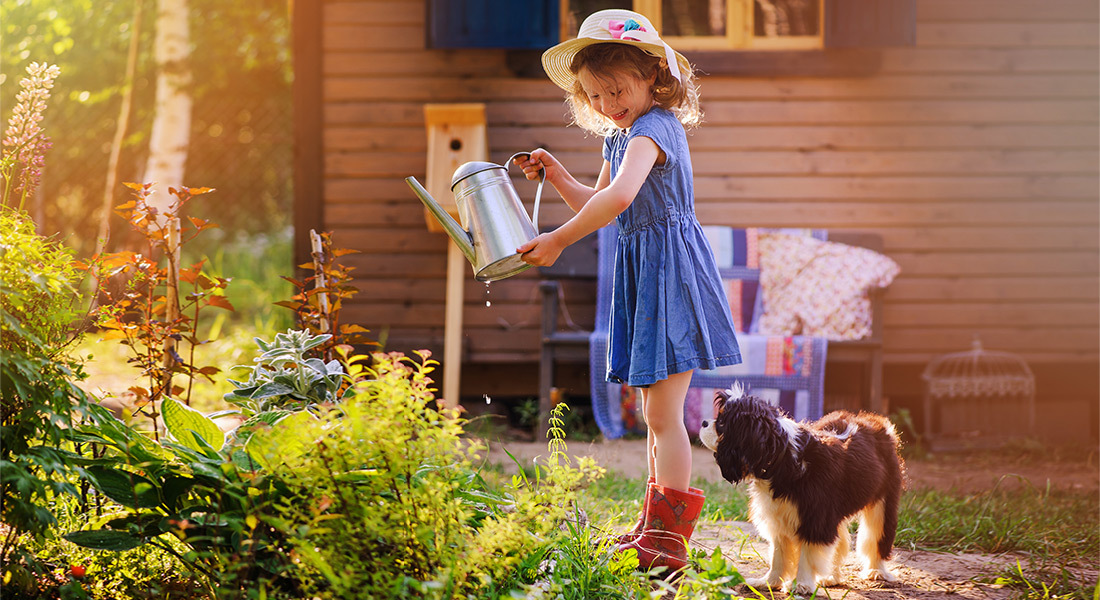What are some tips for watering during the hotter, drier summer months?

There’s an old joke that says Oregonians don’t tan in the summertime, they rust — you know, from all of that “liquid sunshine.” While it’s true that Oregon summers can be a bit rainier and cooler at times — particularly in the northern part of the state — Rogue Valley summers are typically sunny, dry and increasingly hot. And while plants need sunshine to thrive, the soil they’re rooted in needs to remain moist — especially during the peak of the summer season. With that in mind, here is some good information on how different types of soil hold in (or don’t hold in) water, methods for watering, different types of plants with different watering needs, and common watering challenges. Our thanks to the Oregon State University Extension Service for much of the great information found below.
The importance of soil when watering
It’s important to understand the type of soil you have in your yard and garden when talking about watering. If you have sandy soil, water soaks in and drains fairly quickly. If you have clay soil, water soaks in more slowly and it takes longer for the water to reach plant roots. Loam soil is made up of both sandy and clay soil, so water drainage is somewhere in the middle. When conditions are drier and hotter, knowing your soil type can help you make sure you’re watering the correct amount.
Understanding how different methods of watering work
Different methods of watering deliver more (or less) water where your plants need it most. Watering by hand with a hose or using a watering can puts the water exactly where you want it, eliminating waste. But you need to remember to take your time and water deeply.
- Soaker hoses and drip-irrigation systems also allow you to target the soil at the base of your plants, putting the water exactly where you want it. These methods require an initial investment of time and money, but once they’re up and running, they’re very convenient and help conserve water. With drip systems, it can be easy to overwater, as the surface may look dry even though the root area below the surface is wet. To check, poke a screwdriver or similar implement into the soil.
And here’s where knowing your soil type comes into play. In sandy soil, the water soaks straight in, while in clay soil, the water spreads out more horizontally. Because of this, drip emitters can be placed farther apart if you have clay soil.
- Sprinklers are convenient and can cover larger areas of your yard and garden. But they tend to waste water by watering things you don’t need watered — like paths, driveways and unused areas of your yard. To avoid losing water to evaporation and wind drift, water in the early morning (before it gets hot) and when there is little wind. Be aware that since sprinklers get everything in their path wet — including plant leaves — you need to be vigilant about checking for (and dealing with) leaf diseases.
How much water is the right amount?
Many people like to water their yards and gardens on a schedule. But different plants have different needs. So instead of a scheduled set of days or a certain time, it’s better to monitor your garden to determine watering needs throughout the growing season.
- Germinating seeds and seedlings need to be kept moist, but not so wet that they will wash away. Water them with a gentle spray every day or two.
- Developing plants need to be watered deeply, but less often. The goal is to encourage deep root growth. Water to a depth of at least six inches, then let the inch or two on the surface completely dry out before watering again.
- Some crops have shallower root systems and draw their water from the top foot or less of soil. This includes beets, chard, green beans and lettuce. For plants in this group, thoroughly soak the root zone and then don’t water again until the plants show signs of needing additional water. Examples of this include foliage turning a dark bluish green or wilting during the hottest part of the day.
- Some crops have deeper root systems and draw their water from the top two feet of soil. This includes asparagus, corn, rhubarb and tomatoes. Deep-rooted plants need water less often, but you need to make sure the waterings are deep enough to reach the root depth.
Common watering problems to avoid
Understanding some basic watering rules can help you grow a greener, lusher, healthier, more productive garden. Here are some things to keep in mind:
- Frequent, shallow watering creates root systems that are shallow and susceptible to drought.
- Overwatering can fill soil pores with water, leaving little or no oxygen for roots while leaching away necessary nutrients.
- Failing to act after plants show signs of needing water can quickly damage the plants in hot weather. Be sure to check your plants every day or two and respond quickly if you see they are in distress.
Share This
